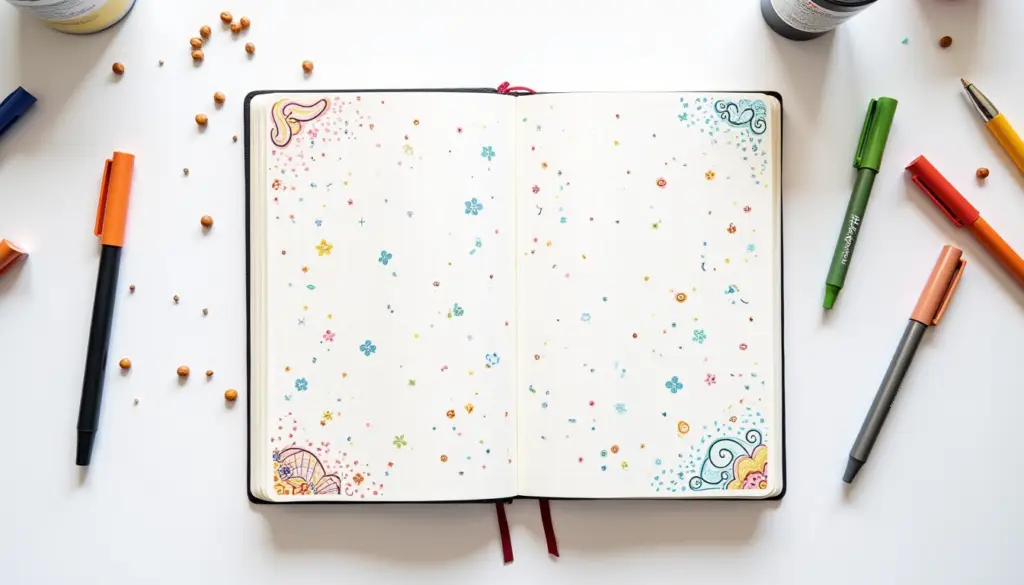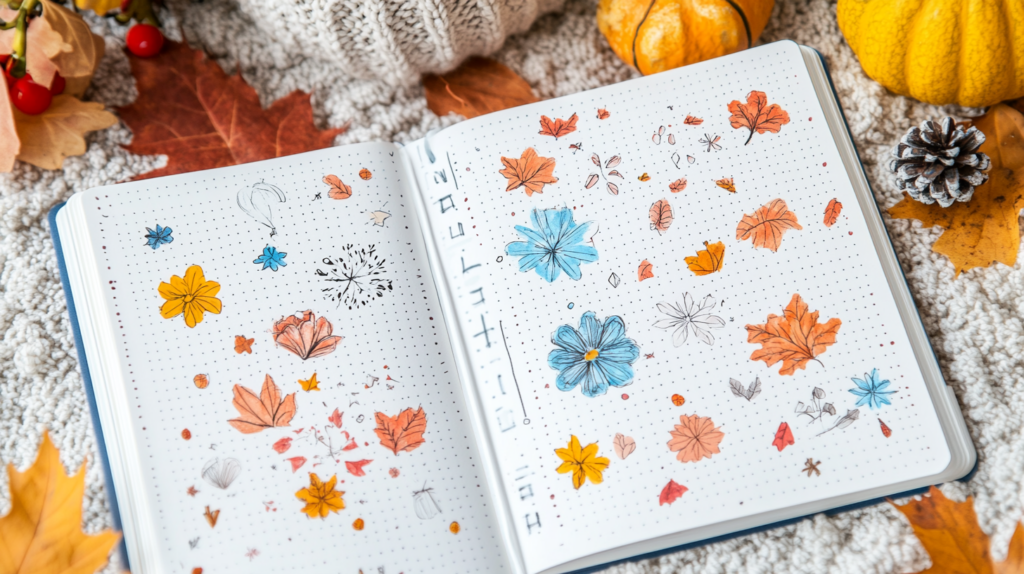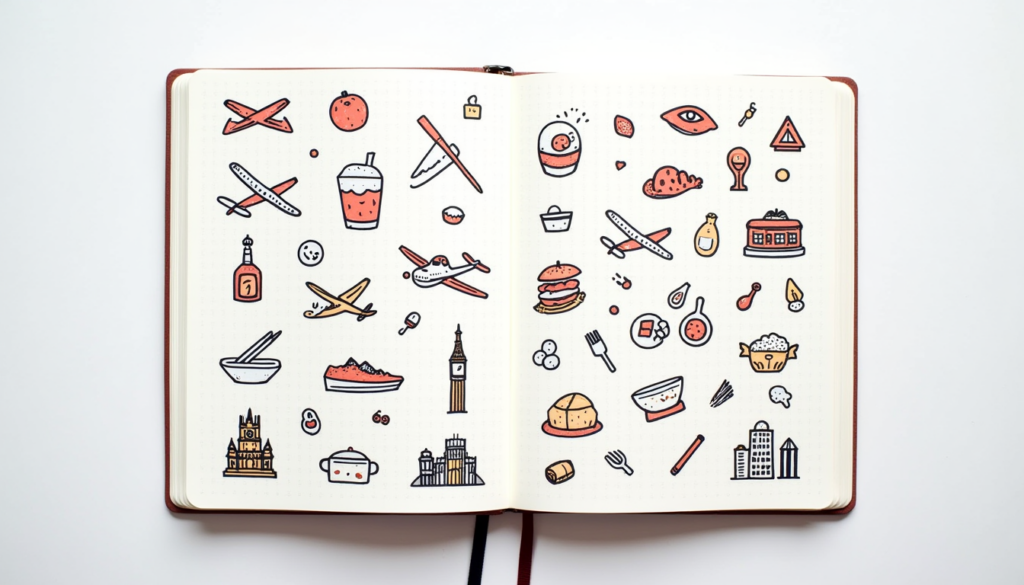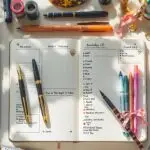The blank page of a bullet journal holds endless possibilities. Adding bullet journal doodles transforms these pages into personal works of art that not only look beautiful but also help express your thoughts and organize your life. First, let’s explore how these simple drawings can turn a functional planner into a creative outlet. Then, you’ll discover how these artistic elements serve as a mirror, reflecting your inner world through visual elements.
For those new to the concept, bullet journaling combines organization with creativity in a customizable system. Adding doodles to this practice enhances both the visual appeal and the emotional connection to your journal. As with any mirror, these creative illustrations reflect back the emotions, ideas, and moments that matter most to you.
Essential Bullet Journal Doodles for Beginners
Starting with bullet journal doodles doesn’t require artistic talent. In fact, even the simplest shapes can add charm and personality to your pages. For example, basic elements like banners, dividers, and borders create structure while adding visual interest to your bullet journal doodles.
Simple designs anyone can master include (see Mood-Tracking Bullet Journal Doodles for how these can be used in tracking):
- Flowers with five petals (draw a small circle, then add five rounded shapes around it)
- Basic clouds (connected semicircles along a horizontal line)
- Stars in various sizes (five pointed stars or simple asterisks)
- Leaf shapes (almond shapes with a simple center line)
- Weather icons (sun, clouds, rain drops)
These elementary designs form the building blocks for more complex artwork. Just as you would start with a basic reflection in a mirror before adding detail, these simple shapes provide the foundation for your creative expression.
When creating monthly spreads, visual elements can establish themes that carry throughout your pages. For instance, January might feature snowflakes and mugs of hot drinks, while July could showcase suns and beach elements (as detailed in the Seasonal Bullet Journal Doodles section below). Similarly, beginner bullet journalists often find that seasonal illustrations offer natural inspiration for their layouts.
Seasonal Bullet Journal Doodles to Enhance Your Pages
Your bullet journal can mirror the changing seasons through thoughtfully chosen doodles. Spring-themed bullet journal doodles bring freshness to your pages with elements like:
- Blooming flowers in various stages
- Rain boots and umbrellas
- Baby animals (chicks, bunnies, lambs)
- Sprouting plants and seeds
- Pastel-colored eggs and nests
Next, summer-inspired bullet journal doodles capture warmth and outdoor activities through:
- Beach elements (waves, shells, sandcastles)
- Ice cream cones and popsicles
- Sunglasses and sun hats
- Camping scenes (tents, campfires, trees)
- Fruit slices (watermelon, strawberries, citrus)
Following the year’s progression, fall and winter bullet journal doodles complete your seasonal journey:
- Autumn leaves in various shapes
- Pumpkins and gourds
- Steaming cups of tea or coffee
- Snowflakes and mittens
- Holiday ornaments and gift boxes
Just as the natural world changes, your bullet journal doodles can reflect these transitions. This creates a visual record that mirrors not only your plans but also the passage of time through recurring seasonal motifs.
Mood-Tracking Bullet Journal Doodles
Perhaps the most personal use of bullet journal doodles comes through mood tracking. Here, doodles serve as a direct mirror to your emotional state. For instance, you might create a monthly grid where each day receives a small drawing that represents your predominant feeling.
Emotional expression through bullet journal doodles might include:
- Sunshine for joy and optimism
- Rain clouds for sadness or melancholy
- Lightning bolts for anger or frustration
- Stars for inspiration or accomplishment
- Hearts for love or connection
Creative mood tracker designs can take many forms. For example, you might draw a tree where each leaf represents a day, coloring or patterning each leaf according to your mood. Alternatively, a year-at-a-glance tracker might use tiny illustrations in a grid format, creating a fascinating visual pattern of your emotional landscape.
Through this practice, your journal truly becomes a mirror, reflecting patterns in your daily life and emotional life. You might notice that certain activities consistently associate with positive doodles, while other commitments correlate with more negative representations. This visual feedback provides valuable self-knowledge that written words alone might not capture.
Bullet Journal Doodles for Special Collections
Beyond daily and monthly spreads, decorative elements enhance special collections pages that track specific interests. Travel enthusiasts might create pages adorned with illustrations of:
- Airplanes, trains, and cars
- Landmark buildings from visited destinations
- Maps with highlighted routes
- Suitcases and travel essentials
- Passport stamps and souvenirs
Similarly, food and recipe collections benefit from culinary sketches like:
- Utensils and cooking tools
- Ingredients in various stages of preparation
- Plated meals with garnishes
- Herb and spice jars
- Recipe cards with decorative corners
For media consumption trackers, bullet journal doodles might include:
- Book covers and bookmarks
- Television screens or movie tickets
- Headphones and music notes
- Rating systems using stars or hearts
- Genre-specific symbols (magnifying glass for mysteries, spaceship for sci-fi)
These specialized bullet journal doodles create visual shorthand for your collections. Like looking in a mirror and immediately recognizing yourself, these doodles help you quickly identify collection pages when flipping through your journal. Additionally, the act of creating these doodles deepens your connection to the subject matter, whether that’s planning your next adventure or cataloging your favorite recipes.
How to Improve Your Bullet Journal Doodles
Advancing your artistic skills happens through deliberate practice and experimentation. First, set aside time specifically for doodling practice outside your main journal. Then, try copying simple designs before gradually adding your personal touch. Similarly, just as you might practice facial expressions in a mirror, practicing these decorative elements helps build muscle memory.
Tools that make bullet journal doodles easier include (find more details in our bullet journal supplies guide):
- Fineliner pens in various tip sizes (0.3mm for details, 0.5mm for outlines)
- Mild gray markers or highlighters for shadows
- Erasable pencils for initial sketches
- Circle stencils for perfect shapes
- Ruler or straight edge for clean lines
A step-by-step approach to more complex bullet journal doodles involves breaking designs into basic shapes. For instance, a detailed flower isn’t just a flower—it’s a circle surrounded by ovals (petals) with lines (stem and leaves). Similarly, complex habit tracker designs begin with a grid structure before adding decorative elements. These can be especially useful for special collections pages described earlier.
Remember that improving your bullet journal doodles takes time. Just as your reflection in a mirror changes gradually over years, your artistic skills develop with consistent practice. The goal isn’t perfection but personal expression and enjoyment of the process.
Incorporating Bullet Journal Doodles into Your Daily Practice
Making bullet journal doodles part of your regular routine requires practical strategies. Time-saving techniques include (learn more about journaling habits):
- Creating a personal “doodle dictionary” of go-to designs
- Preparing borders and headers in advance
- Using sticky notes to practice designs before adding them to your journal
- Keeping reference photos or sketches nearby
- Setting a timer for 5-10 minutes of focused doodling
Integrating doodles with your existing bullet journal setup means finding natural places for visual elements. For example, you might add small bullet journal doodles beside important tasks, use them as custom bullets for different categories, or create doodled headers for each new day or week. The best approach, as outlined in the bullet journal guide and Essential Bullet Journal Doodles for Beginners section, is to start simple and gradually increase complexity.
Beyond aesthetics, bullet journal doodles boost creativity and mindfulness. The act of doodling occupies your hands while freeing your mind to process information differently. For many practitioners, the meditative quality of creating bullet journal doodles provides a welcome break from digital screens and constant productivity demands.
Just as gazing into a mirror can be a moment of self-reflection, the time spent on bullet journal doodles offers valuable introspection. This creative pause often leads to insights about priorities, goals, and emotional patterns that might otherwise go unnoticed in the rush of daily life.
Conclusion
Bullet journal doodles transform ordinary planning pages into personal works of art that reflect your unique journey. Through simple shapes and thoughtful designs, your journal becomes both functional and beautiful. Like a mirror that shows not just your appearance but also your creative spirit, bullet journal doodles capture aspects of your experience that words alone cannot express.
Starting with simple bullet journal doodles builds confidence and skill. Over time, these visual elements become a natural extension of your journaling practice. Whether tracking habits, planning months, or recording special memories, the doodles you create add dimension and personality to your bullet journal.
As you continue your journaling journey, remember that the most meaningful bullet journal doodles aren’t necessarily the most technically impressive. Rather, they’re the ones that authentically reflect your life, interests, and growth. With each page you create, you’re not just planning your days—you’re creating a mirror that reflects your evolving story through art and organization combined. For more inspiration, check out our bullet journal themes and advanced techniques.
References
Buko, S. (2021). The Therapeutic Benefits of Art Journaling. Journal of Expressive Arts Therapy, 45(2), 112-128. https://expressivearts.edu/publications/art-journaling-benefits
Greenwood, J. (2023). Visual Thinking: The Science Behind Doodling. Cognitive Research Journal, 18(4), 347-362. https://cognitiveresearch.org/visual-thinking-doodling
Harris, K. (2022). Mindful Creativity: How Art Practices Reduce Stress. Mindfulness Studies Review, 9(1), 73-89. https://mindfulnessstudies.org/art-stress-reduction
Reynolds, P. (2024). The Evolution of Bullet Journaling: From Organization to Self-Expression. Digital vs. Analog Planning, 12(3), 205-219. https://plannerresearch.org/bujo-evolution
Wilson, M. (2023). Drawing as Reflection: Visual Journaling in Therapeutic Settings. Art Therapy Journal, 30(2), 154-168. https://arttherapyassociation.org/visual-journaling-therapy






